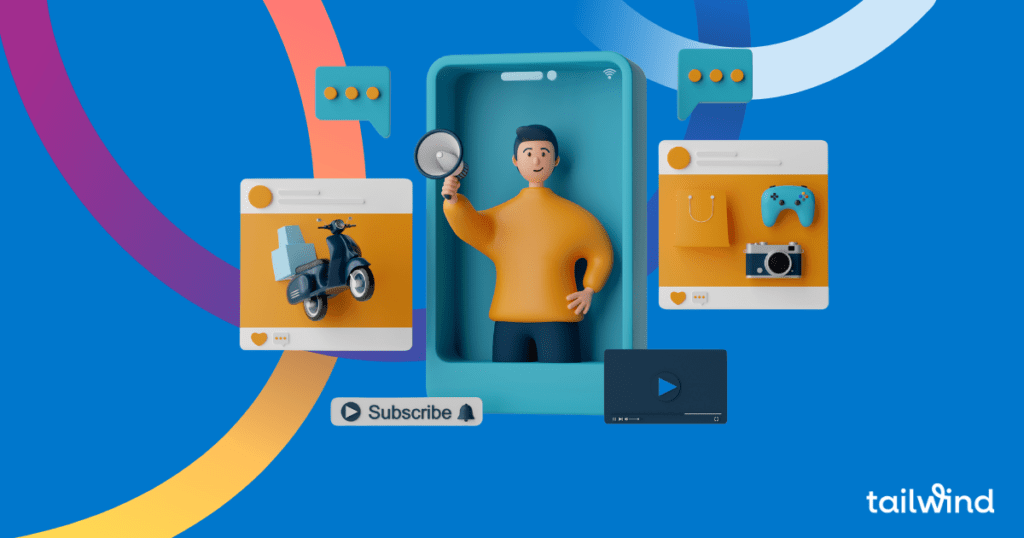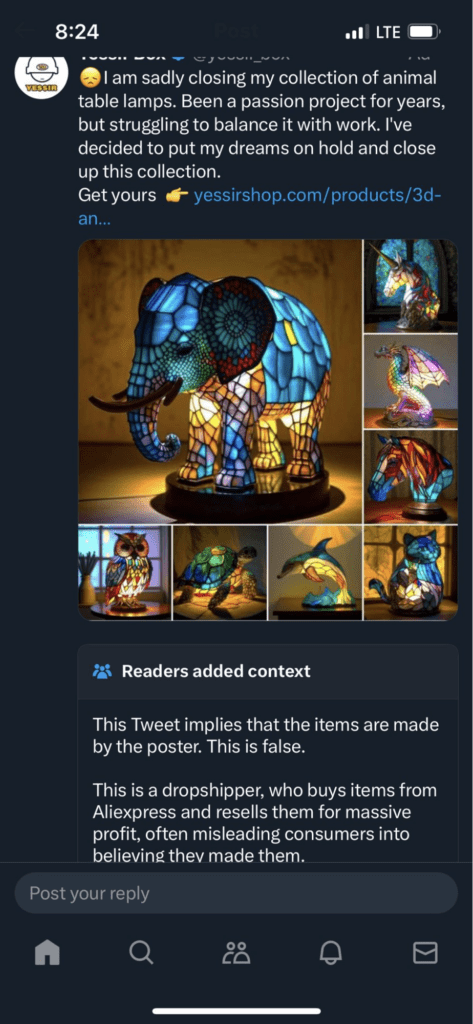
Performance marketing has always been the go-to method for online stores. High ROAS, immediate results — what is there not to like?
Well, there is one thing: If your ad account gets banned or you switch off the campaign your sales could plummet to zero overnight. Not really a long-term brand-building strategy.
Fortunately, those same platforms where you are paying for each click also allow you to build an audience that you can grow and funnel to your store page!
Developing a Social Media Ecommerce Strategy
To effectively leverage social media for ecommerce, a well-defined strategy is essential. It should harmonize your goals with content creation and balance paid and organic tactics.
Setting Clear Goals
First, establish what you aim to achieve with your social media ecommerce efforts. Whether it’s increasing brand awareness, driving sales, or growing your community, your goals need to be SMART: Specific, Measurable, Achievable, Relevant, and Time-bound.
- Brand Awareness: Gaining visibility among potential customers.
- Sales Conversion: Turning followers into customers.
- Community Engagement: Building brand loyalty and repeat purchases.
Content Strategy for Ecommerce
Your content strategy should serve the dual purpose of engaging your audience and promoting your products. Plan a mix of content types to keep your feed dynamic and interesting.
- Product Showcases: Highlight the features and benefits of your products.
- User-Generated Content: Share reviews and photos from satisfied customers.
- Educational Posts: Provide value with tips related to your product or industry.
Use a content calendar to maintain a consistent posting schedule that aligns with your audience’s most active times on social media.
Paid vs. Organic Approach
Understand the difference and complementary nature of paid and organic strategies. Organic reach is cost-effective but can be challenging due to algorithm changes, whereas paid content ensures visibility to a targeted audience.
| Approach | Benefits | Considerations |
| Organic | Builds real connections, cost-effective | Takes time to grow, less predictable reach |
| Paid | Immediate reach, precise targeting | Requires budget, needs ongoing optimization |
Allocate your resources based on what works best for your brand and audience, and be prepared to adjust as you analyze performance data.
Key Platforms To Consider
When selecting a platform for social media ecommerce, your choice should align with your target audience and the type of products you sell. Each platform has distinct features suitable for different marketing strategies.
Facebook offers a mature environment for social commerce platforms. With Facebook Shops you can showcase your products directly on your page, facilitating a seamless shopping experience for customers. The platform’s extensive user base makes it effective for ecommerce marketing strategies, reaching diverse demographics. (The audience filter options are out-of-this-world!)
On Pinterest, visual appeal is paramount. The platform’s Buyable Pins allow users to purchase your products without leaving the app, making it an ideal place for lifestyle and creative goods. As one of the best social media for online sales, especially for visual inspiration, Pinterest can significantly boost your product visibility.
Want to start with Pinterest? Try Tailwind!
TikTok
TikTok’s short-form video content is reshaping social media marketing in ecommerce. With features like shoppable ads, you can tap into a younger audience eager for entertainment and instant purchases. The platform is highly engaging, offering creative methods to market your products.
Instagram is a powerhouse for social commerce platforms, perfect for brands with a strong visual identity. The platform’s Shopping feature integrates directly with your product catalog, and the ecommerce potential is amplified through stories, posts, and IGTV. User engagement on Instagram is high, which can be leveraged for driving sales.
Want to start with Instagram? Try Tailwind!
Twitter’s real-time nature offers unique opportunities for ecommerce marketing strategies. Although it doesn’t have a built-in shopping feature, you can use targeted tweets and hashtags to drive traffic to your website and engage with customers directly, which can help in fostering brand loyalty. As the platform is not that popular in ecomm, it offers quite cheap clicks. Just be aware of the community notes…

Reddit has niche communities, called subreddits, which can be valuable for targeted ecommerce social media campaigns. It’s crucial to engage authentically with these communities to build trust. Reddit’s user base, while not traditionally used for direct sales, can be influential in gaining insights and driving focused traffic to your site. As in the examples above, cheap clicks if compared with some of the better-known platforms.
Building Brand Awareness and Engagement
Building brand awareness and engagement on social media hinges on authenticity and connection.
Your strategy should focus on creating relatable content that resonates with your audience, encouraging their participation.
Leveraging User-Generated Content
To build brand awareness, encourage your customers to share their own experiences with your products. User-generated content (UGC) not only increases your content volume but also boosts authenticity.
- Ask for photos or videos of customers using your products.
- Create contests where customers post their content with a specific hashtag.
- Feature UGC on your social media to acknowledge and reward contributors.
Importance of Social Proof
Social proof underscores the influence that reviews and testimonials have on consumer behavior.
- Showcase positive reviews prominently on your social channels.
- Share customer testimonials in posts and stories.
| Method | Purpose |
| Reviews | Build trust by showing real-world satisfaction. |
| Testimonials | Personal stories add depth to product benefits. |
Integrating social proof into your social media strategy bolsters brand reputation and encourages engagement through relatable, trusted content.
Optimizing for Conversions and Sales Growth
To effectively increase your sales and conversions through social media ecommerce, your strategy needs to focus on seamless shopping experiences and simplified transaction processes.
Creating Shoppable Posts
To drive sales through social media, integrate shoppable posts into your content. These are posts where customers can click on a tagged product that directly links them to your online store, making the path from discovery to purchase shorter and more intuitive. Here’s how you should approach them:
- Product Tags: Add tags to the products featured in your images or videos. Ensure each tag links directly to the item’s purchase page to facilitate immediate action.
- High-Quality Visuals: Use crisp, clear images or videos to showcase your products. The better your product looks, the more likely users are to click through.
- Accurate Descriptions: Provide succinct and precise product descriptions. Highlight key features and benefits to inform and entice your audience.
Simplifying the Checkout Process
A smooth and efficient checkout process is crucial for closing sales. Minimizing obstacles here can directly influence your conversion rates and revenue. Implement these tactics:
- Fewer Steps: Aim for the fewest possible steps to go from product page to purchase confirmation. Trim any non-essential fields from the checkout form.
- Payment Options: Offer a variety of payment methods, including mobile wallets and one-click purchasing options, to cater to user preferences.
- Clear Navigation: Make sure the next steps are always obvious. Use bold buttons for actions like “Add to Cart” and “Proceed to Checkout,” and display a progress bar to inform users of their status in the checkout process.
Enhancing Customer Experience on Social Platforms
To excel in social media ecommerce, prioritizing your customer’s experience through responsive communication and support is essential.
Utilizing Chatbots and Messaging
Incorporating chatbots into your social media platforms can significantly streamline the shopping experience. Chatbots provide instant responses to common inquiries, allowing customers to receive immediate assistance at any time. A well-programmed chatbot can handle a variety of tasks:
- Answering frequently asked questions
- Guiding users through the purchase process
- Providing personalized product recommendations
Leverage chatbots to enable social selling by integrating them with your product catalog. This allows customers to browse and even initiate purchases directly through messaging interfaces.
Effective Customer Service and Support
Your customer service approach on social media must be prompt and helpful. By ensuring your team offers effective customer support, you can resolve issues quickly and maintain customer satisfaction. For optimal support:
- Monitor all social media channels for customer inquiries and feedback.
- Respond promptly to all customer communications.
- Train your team to understand the platform’s specific features and user expectations.
By managing these elements effectively, you build trust and encourage repeat business, enhancing the overall customer experience on your social media channels.
Leveraging Advertising and Promotions
In the realm of social media ecommerce, your success often hinges on how effectively you can use advertising and promotions to reach potential customers.
By employing targeted advertising strategies and organizing engaging giveaways and contests, you can significantly enhance your brand’s visibility and customer engagement.
Targeted Advertising Strategies
To maximize the impact of your advertising efforts, you should focus on targeted ads. These are advertisements designed to reach a specific audience based on their interests, behaviors, and demographics. By analyzing user data, social media platforms offer comprehensive tools to create ads tailored to your ideal customer profile.
- Demographic Targeting: Specify the age, gender, location, and even the income level of the users you want to see your ads.
- Interest-Based Targeting: Select user interests relevant to your product, which helps in delivering your ad to users most likely to engage with it.
- Behavioral Targeting: Target users based on their past activity, such as previous purchases and website visits.
Paid advertising options vary, but here are the most common ad types:
- Image Ads: Simple yet effective ads that use striking visuals to grab attention.
- Video Ads: More engaging ads that can tell a story or demonstrate a product’s use.
- Carousel Ads: Allow multiple images or videos in a single ad, perfect for showcasing different product features or a product line.
Using these strategies enables you to place your product directly in front of the users who are most likely to purchase, ensuring a better return on your advertising spend.
Organizing Giveaways and Contests
Giveaways and contests are powerful promotional tools that can increase your brand’s reach and engage with your audience on a deeper level. They create excitement around your brand and encourage users to interact with your content.
- Rules and Rewards: Clearly outline how to enter, what users can win, and when winners will be chosen. Prizes should be desirable and relevant to your brand to attract the right participants.
- Promotion: Utilize your social media channels to promote your giveaways, ensuring your existing audience is aware and can share it with others.
- Engagement: Foster engagement by asking participants to like, comment, share, or tag friends. This can increase the visibility of your campaign, leading to enhanced brand awareness and a larger following.
Remember to comply with all platform guidelines when organizing these promotions, and make disclosures about partnerships or sponsored content where applicable.
Measuring Success and Analytics
In social media ecommerce, the evaluation of your efforts is as crucial as the strategy itself. You need to know what works to refine your campaigns and make informed decisions.
Your business should focus on diverse KPIs to gauge success effectively:
- Traffic: Measure the number of visitors coming to your site via social channels.
- Engagement: Assess how users interact with your content, including likes, shares, and comments.
- Conversion Rates: Keep track of the percentage of social media traffic that takes a desired action on your site.
- Customer Growth: Monitor the rate at which new customers are acquired through social media efforts.
Strategically setting and reviewing these KPIs helps you understand the return on investment (ROI) from your social media activities.
Fostering an Online Community
Creating a vibrant online community is central to harnessing the long-term benefits of social media ecommerce. Your engagement levels and the community you build around your brand can convert followers into loyal customers.
Engaging with the Audience
Your interactions with your audience set the tone for your online presence. When content creators engage, they create an active and responsive environment. Consider these methods:
- Respond promptly: React quickly to comments, questions, and messages to show your audience they’re heard.
- Host Q&A sessions: Utilize live videos to interact in real-time, allowing for a more personal connection.
- Use polls and surveys: These not only engage but also gather valuable feedback.
| Method | Purpose | Engagement Type |
| Responding to comments | Show attentiveness and build trust | Reactive |
| Hosting Q&A sessions | Foster real-time conversation | Proactive |
| Using polls and surveys | Gather insights and stimulate participation | Interactive |
Creating a Sense of Community
A sense of community strengthens the relationship between your brand and your social media audience. Strategies to foster this include:
- Create a branded hashtag: It becomes a gathering point for discussions and user-generated content.
- Feature community content: Sharing user posts demonstrates appreciation and encourages more submissions.
- Hold events or challenges: These can spur community interaction and content creation.
Summary
Building the social presence of your brand will take a lot of time and work. The main advantage is that the resources that you put in will compound.
Apart from building a following that you can repeatedly “talk to,” in many cases, your performance marketing prices will become a bit lower, as the algorithms will know that users like to engage with your pages and profiles.
Start building today!





